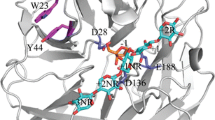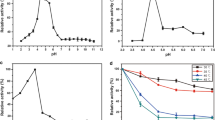Abstract
The genes of two α-l-arabinofuranosidases (AbfI and II) from family GH 62 have been identified in the genome of Aspergillus fumigatus wmo. Both genes have been expressed in Pichia pastoris and the enzymes have been purified and characterized. AbfI is composed of 999 bp, does not contain introns and codes for a protein (ABFI) of 332 amino acid residues. abfII has 1246 bp, including an intron of 51 bp; the protein ABFII has 396 amino acid residues; it includes a family 1 carbohydrate-binding module (CBM) in the N-terminal region, followed by a catalytic module. The sequence of ABFI and the catalytic module of ABFII show a 79 % identity. Both enzymes are active on p-nitrophenyl α-l-arabinofuranoside (pNPAra) with KM of 94.2 and 3.9 mM for ABFI and II, respectively. Optimal temperature for ABFI is 37 °C and for ABFII 42 °C, while the pH optimum is about 4.5 to 5 for both enzymes. ABFII shows a higher thermostability. When assayed using natural substrates, both show higher activity over rye arabinoxylan as compared to wheat arabinoxylan. ABFII only is active on sugar beet pulp arabinan and both are inactive towards debranched arabinan. The higher thermostability, higher affinity for pNPAra and wider activity over natural substrates shown by ABFII may be related to the presence of a CBM. The availability of the recombinant enzymes may be useful in biotechnological applications for the production of arabinose.






Similar content being viewed by others
References
Seri, K., Sanai, K., Matsuo, N., Kawakubo, K., Xue, C., & Inoue, S. (1996). l-Arabinose selectively inhibits intestinal sucrase in an uncompetitive manner and suppresses glycemic response after sucrose ingestion in animals. Metabolism, 45, 1368–1374.
Wong, D. W. S. (2008). Enzymatic deconstruction of backbone structures of the ramified regions in pectins. Protein Journal, 27, 30–42.
Wong, D. W. S., Chan, V. J., & Batt, S. B. (2008). Cloning and characterization of a novel exo-α-1,5-l-arabinanase gene and the enzyme. Applied Microbiology and Biotechnology, 79, 941–949.
De La Mare, M., Guais, O., Bonnin, E., Weber, J., & Francois, J. M. (2013). Molecular and biochemical characterization of three GH62 α-l-arabinofuranosidases from the soil deuteromycete Penicillium funiculosum. Enzyme and Microbial Technology, 53, 351–358.
Numan, M. T., & Bhosle, N. B. (2006). α-l-Arabinofuranosidases: the potential applications in biotechnology. Journal of Industrial Microbiology and Biotechnology, 33, 247–260.
Cantarel, B. L., Coutinho, P. M., Rancurel, C., Bernard, T., Lombard, V., & Henrissat, B. (2009). The carbohydrate-active EnZymes database (CAZy): an expert resource for glycogenomics. Nucleic Acids Research, 37, D233–D238.
Couturier, M., Haon, M., Coutinho, P. M., Henrissat, B., Lesage-Meessen, L., & Berrin, J.-G. (2011). Podospora anserine hemicellulases potentiate the Trichoderma reesei secretome for saccharification of lignocellulosic biomass. Applied and Environmental Microbiology, 77, 237–246.
Siguier, B., Haon, M., Nahoum, V., Marcellin, M., Burlet-Schiltz, O., Coutinho, P. M., Henrissat, B., Mourey, L., O’Donohue, M. J., Berrin, J.-G., Tranier, S., & Dumon, C. (2014). First structural insights into α-l-arabinofuranosidases from the two GH62 glycoside hydrolase subfamilies. Journal of Biological Chemistry, 289, 5261–5273.
Maehara, T., Fujimoto, Z., Ichinose, H., Michikawa, M., Harazono, K., & Kaneko, S. (2014). Crystal structure and characterization of the glycoside hydrolase family 62 α-l-arabinofuranosidase from Streptomyces coelicolor. Journal of Biological Chemistry, 289, 7962–7972.
Wang, W., Mai-Gisondi, G., Stogios, P. J., Kaur, A., Xu, X., Cui, H., Turunen, O., Savchenko, A., & Master, E. R. (2014). Elucidation of the molecular basis for arabinoxylan-debranching activity of a thermostable family GH62 α-l-arabinofuranosidase from Streptomyces thermoviolaceus. Applied and Environmental Microbiology, 80, 5317–5329.
Henrissat, B., & Bairoch, A. (1996). Updating the sequence-based classification of glycosyl hydrolases. Biochemical Journal, 316, 695–696.
Rosa, L., Ravanal, M. C., Mardones, W., & Eyzaguirre, J. (2013). Characterization of a recombinant α-glucuronidase from Aspergillus fumigatus. Fungal Biology, 117, 380–387.
Mandels, M., & Weber, J. (1969). The production of cellulases. Advances in Chemistry Series, 5, 391–414.
Park, B. H., Karpinets, T. V., Syed, M. H., Leuze, M. R., & Uberbacher, E. C. (2010). CAZymes analysis toolkit (CAT): web service for searching and analyzing carbohydrate-active enzymes in a newly sequenced organism using CAZy database. Glycobiology, 20, 1574–1584.
Nielsen, H., Engelbrecht, J., Brunak, S., & von Heijne, G. (1997). A neural network method for identification of prokaryotic and eukaryotic signal peptides and prediction of their cleavage sites. International Journal of Neural Systems, 8, 581–599.
Bollag, D. M., & Edelstein, S. J. (1991). Protein methods. NY: Wiley-Liss.
McIlvaine, T. C. (1921). A buffer solution for colorimetric comparison. Journal of Biological Chemistry, 49, 183–186.
Cubero, B., & Scazzochio, C. (1994). Two different, adjacent and divergent zinc finger-binding sites are necessary for CREA-mediated carbon catabolite repression in the proline gene cluster of Aspergillus nidulans. The EMBO Journal, 13, 407–415.
van Peij, N. N., Visser, J., & de Graaff, L. H. (1998). Isolation and analysis of XlnR, encoding a transcriptional activator co-ordinating xylanolytic expression in Aspergillus niger. Molecular Microbiology, 27, 131–142.
Denison, S. H. (2000). pH regulation of gene expression in fungi. Fungal Genetics and Biology, 29, 61–71.
Hashimoto, K., Yoshida, M., & Hasumi, K. (2011). Isolation and characterization of CcAbf62A, a GH62 α-l-arabinofuranosidase, from the basidiomycete Coprinopsis cinerea. Bioscience, Biotechnology, and Biochemistry, 75, 342–345.
Kaur, A. P., Nocekm, B. P., Xum, X., Lowdenm, M. J., Leyvam, J. F., Stogiosm, P. J., Cuim, H., Di Leo, R., Powlowski, J., Tsang, A., & Savchenko, A. (2015). Functional and structural diversity in GH62 α-l-arabinofuranosidases from the thermophilic fungus Scytalidium thermophilum. Microbial Biotechnology, 8, 419–433.
Bauer, S., Vasu, P., Persson, S., Mort, A. J., & Somerville, C. R. (2006). Development and application of a suite of polysaccharide-degrading enzymes for analyzing plant cell walls. Proceedings of the National Academy of Sciences of the United States of America, 103, 11417–11422.
Sakamoto, T., Ogura, A., Inui, M., Tokuda, S., Hosokawa, S., Ihara, H., & Kasai, N. (2011). Identification of a GH62 α-l-arabinofuranosidase specific for arabinoxylan produced by Penicillium chrysogenum. Applied Microbiology and Biotechnology, 90, 137–146.
Guillen, D., Sanchez, S., & Rodriguez-Sanoja, R. (2010). Carbohydrate-binding domains: multiplicity of biological roles. Applied Microbiology and Biotechnology, 85, 1241–1249.
Acknowledgments
This work has been supported by grants from the Fondo Nacional de Ciencia y Tecnología (FONDECYT) (1130180), and Universidad Andrés Bello (DI-478-14/R and DI-31-12/R).
Author information
Authors and Affiliations
Corresponding author
Ethics declarations
Conflict of Interest
The authors declare that they have no competing interests.
Additional information
Highlights
The gene coding for two GH 62 arabinofuranosidases (abfI and II) have been sequenced.
Both genes have been heterologously expressed in Pichia pastoris.
The enzymes (ABFI and II) have been purified and characterized.
Both enzymes belong to sub-family GH 62-1, but ABFII possesses a carbohydrate-binding module.
ABFII shows higher stability and broader substrate specificity.
Electronic Supplementary Material
Below is the link to the electronic supplementary material.
Fig. S1
Nucleotide sequence of abfI and amino acid sequence of ABFI. The translation start and termination codons are in bold. (DOCX 99 kb)
Fig. S2
Nucleotide sequence of abfII and amino acid sequence of ABFII. The translation start and termination codons are in bold. The intron sequence is in small letters. (DOCX 19 kb)
Fig. S3
CLUSTAL W alignment of the amino acid sequences of ABFI and of ABFII. The sequence of the CBM of ABFII is underlined. The catalytic residues are boxed. Vertical lines show the end of the signal peptides as predicted by SignalP. (DOCX 43 kb)
Fig. S4
Promoter sequences of the abfI (A) and abfII (B) genes. The TATA box of abfI is highlighted. (DOCX 146 kb)
Fig. S5
Multiple sequence alignment of a set of fungal GH 62 ABFs. The alignment was performed with CLUSTAL Omega. The catalytic amino acids are boxed. The sequences are from: Aspergillus nidulans (EAA59562); Aspergillus niger (CAK38069); Aspergillus sojae (BAA 85252); Aspergillus tubingensis (CAB01408); Bipolaris zeicola (AAG42252); Chrysosporium lucknowense (AED84983); Penicillium capsulatum (CAM07245); Penicillium chrysogenum (BAG71682); Podospora anserina (CAP62366); Trichoderma reesei (AAP57750); Ustilago maydis (XP_011391032); Coprinopsis cinerea (AB557888); Scytalidium thermophilum (AbfA, AHZ56658); Scytalidium thermophilum (AbfC, AHZ56660); Penicillium funiculosum (abf62a, b and c; De La Mare et al. 2013); ABFI (this work; KU160789); ABFII (this work; KU160799) (DOCX 30 kb)
Table S1
(DOCX 31 kb)
Table S2
(DOCX 32 kb)
Rights and permissions
About this article
Cite this article
Pérez, R., Eyzaguirre, J. Aspergillus fumigatus Produces Two Arabinofuranosidases From Glycosyl Hydrolase Family 62: Comparative Properties of the Recombinant Enzymes. Appl Biochem Biotechnol 179, 143–154 (2016). https://doi.org/10.1007/s12010-016-1984-0
Received:
Accepted:
Published:
Issue Date:
DOI: https://doi.org/10.1007/s12010-016-1984-0




